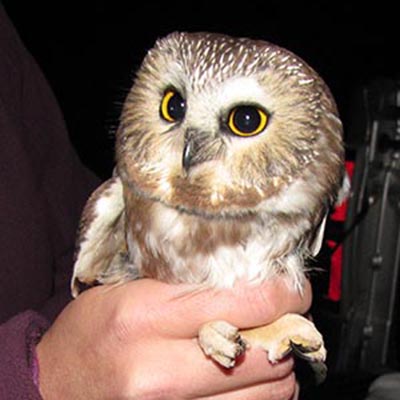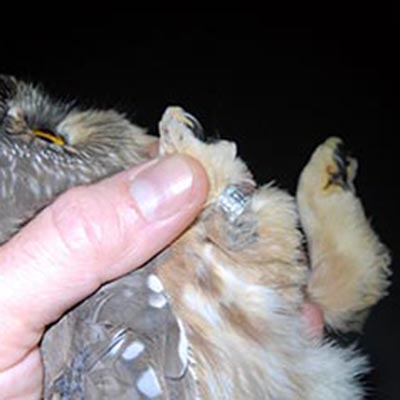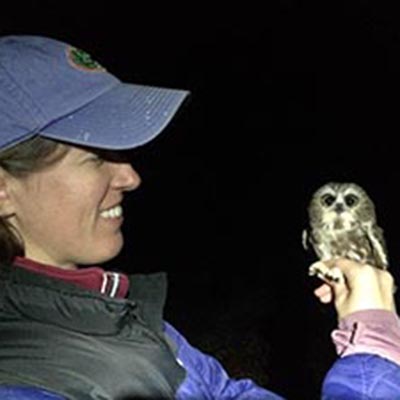Northern Saw-whet Migration
Background

Saw-whets are a small owl species (they weigh about 1/5 of a pound) that breeds in forests across the northern United States and southern Canada. Northern Saw-whet Owls can be easily distinguished from other owls by their small size and markings such as the white “V” over their eyes. They eat mice as well as other small rodents, birds, and insects. They make a variety of vocalizations, and are named for one of their calls, which is said to sound like a saw being sharpened, or “whetted.”
Approach

During fall migration each year, owls are captured between dusk and dawn using fine mesh nets erected around an audiolure—an audio system playing saw-whet owl calls. Owls attracted by the calls fly into the nets, are caught in the mesh, and are harmlessly extracted, banded, aged, and released by BRI biologists. Each owl is fitted with a uniquely numbered metal band on their leg, which allows the individual bird to be identified if it is recaptured. Researchers use an ultraviolet light to determine the age class of owls. Recently molted feathers reflect a brighter pink color under ultraviolet light compared to older feathers.
BRI’s saw-whet banding efforts are part of Project Owlnet, a collaboration of owl researchers across North America.
Migration Patterns

Like other boreal-nesting owls, Northern Saw-whet Owl populations undergo cyclical variations thought to be related to changes in prey populations. In some years, relatively few owls are captured during fall migration, while in other years, huge numbers of mostly young owls (born earlier in the year) head south on their first migration.
Banded owls recaptured at different locations or in subsequent years can provide important information on potential migration patterns. Owls recaptured in Maine by BRI biologists have come from a wide range of initial banding locations, most often from northern Québec.
Outreach and Additional Information

Outreach
In recent years, banding efforts have focused on several locations in southern Maine. BRI researchers sometimes take school groups and private citizens out to observe banding efforts in October of each year. If you are interested in joining us during owl banding, contact Patrick Keenan (patrick.keenan@briwildlife.org) for more information.
Additional Information
DeSorbo C, Wright K, Johnson I, Gray R (2012) Bird migration stopover sites: ecology of nocturnal and diurnal raptors at Monhegan Island. Biodiversity Research Institute report (BRI ID # 2012-08) submitted to: Maine Outdoor Heritage Fund, and the Davis Conservation Foundation, Pittston, Maine, and Falmouth, Maine, pp 43
Tony Oppersdorff. “The Northern Saw-Whet Owl: Coastal Maine’s Tiny Migrant.“ Maine Boats, Homes and Harbors, June/July 2011.


